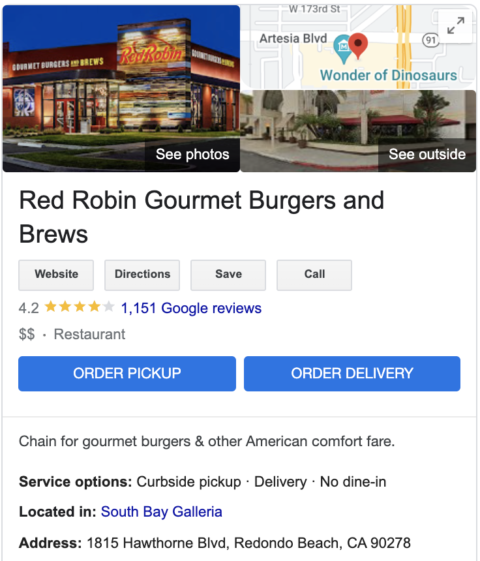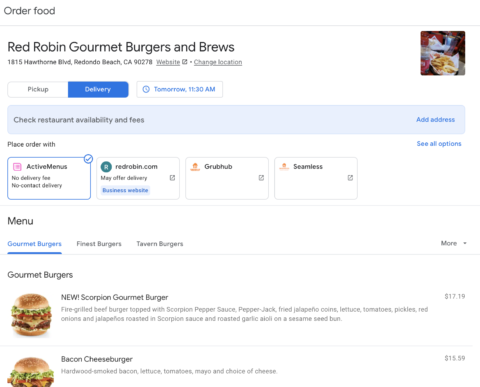Local SEO Guide For Ecommerce & Online Ordering

With the onset of the COVID-19 pandemic, the ability to order online has become an essential feature of every webpage and business listing.
Before the pandemic, the primary goal of local search engine optimization (SEO) was to drive visibility and foot traffic to the site.
Companies are now focusing on providing a comprehensive omni-channel experience to allow the customer to order online, whether directly within the menu or on an individual site page.
This also allows customers to choose how they want to receive their products with delivery or pick up options that best suit their needs.
With this shift, the strategy for how to maximize the brand’s online ordering experience has changed.
In this post, we will be sharing our local SEO guide for ecommerce and online ordering to promote more conversions.
Maximize retail listings for online ordering
When searching online for something to buy, customers are more likely to interact with a business’s listing as their first point of contact.
Menu preparation to direct customers to order online or visit your website is essential.
The order link should take the customer directly into the order flow so that they can start the purchase process.
There needs to be as little friction as possible to allow them to get started and place their order.
Direct your customer to a menu page, a major category breakdown, or a streamlined search function.
Under the menu, you can also share the options available for picking up the order, such as in-store pickup, curbside pickup, same-day delivery, or standard delivery.
These are known as attributes, and each applicable retail attribute should be selected for each of your listings to provide as much information as possible to the searcher.
New Google themes are updated and added on a consistent basis, so make sure you keep an eye on what’s available and applicable to your brand regularly.
Local inventory ads for retailers
To reduce as much friction as possible and increase order for certain products, retailers should think about this Local inventory ads.
By setting up these types of ads for brand sites, customers can see specific products that are available on that site.
It also allows the listing to rank specific products a customer might search for on Google and display what is currently available on the site if they are interested in selecting their order.
This creates a streamlined omnichannel experience for the customer while encouraging faster conversions.
Here you can see an example Local inventory ads under the list of Google Business Profiles.
The above list shows the products in stock at the locations and what is associated with the customer’s search behaviour.
When a customer clicks on a product advertisement, they will be directed to that retailer’s Google hosted storefront.
Google provides files Necessary requirements To set up a local product feed so that you can take advantage of this feature in your listing.
Google provides metrics to allow brands to measure the performance of these digital ads.
the Basic setup for implementation Details of what is required to set this up for the retailer.
This is currently only available for brick and mortar locations in Australia, Austria, Brazil, Canada, Denmark, France, Germany, Ireland, Japan, Netherlands, New Zealand, Norway, Poland, Sweden, Switzerland, United Kingdom and United States.
If you’ve done basic setup for your local stock product feed, there are several Optimization features.
These improvements include a A local storefront hosted by a merchantAnd Offer to orderAnd Pickup today Features.
To get started, you can contact your Google representative Local warehouse ads support Team.
Online ordering for restaurants
Sites whose primary category is set as Restaurant have the ability to display online ordering directly in their menus.
This functionality can be managed directly within the restaurant website business Google profile by going to the food ordering option in the left panel.
To run it you will go to Set up the “Order Online” button.
By updating this functionality, your menu will then display an option to order pickup or delivery, which will direct the customer to https://food.google.com/ for that individual location.
The image below shows what this would look like in practice.
 Image from Google Business Profile, February 2022
Image from Google Business Profile, February 2022The user will then be shown the different options available for ordering from the restaurant.
The customer can choose to order directly from the restaurant or select a third party such as UberEats, DoorDash, Grubhub, Seamless or any partners the site works with.
For embedded sites, customers will be able to order directly within Google.
It will display the menu items available on this site with the specified pricing.
They will also be allowed to make any available modifications to their application.
When the order is ready to be completed, the customer will be able to checkout directly within Google.
This convenience allows the customer to stay on Google and use any credit card information they already have saved with Google.
This creates a smooth and streamlined ordering process where check-out can take place in a matter of seconds.
 Image from Google Business Profile, February 2022
Image from Google Business Profile, February 2022Preparing orders with Google for Restaurants
If a restaurant wants to have the ability to allow customers to order from Google directly, there are a few steps they need to go through.
Restaurants can be visited Ask with Google help page To find out if they are eligible for the service.
First, the restaurant must work with an approved third-party ordering provider such as Olo.
This is required since third party ordering platforms have integration with Google.
Next, trademarks will need to fill out a file interest form with Google to start the process.
Developers can review documentation To ensure that they can meet the necessary launch requirements.
There too Launch readiness checklist provided by Google once approved by you.
Zoom in on the website pages for online ordering
The website pages should also be optimized for online ordering just like the website menu.
There should be clear calls to action (CTAs) on the page letting the customer know that an order can be initiated.
It should highlight the options available to the customer to receive their products for pickup, curbside, or delivery.
The page should clearly identify any essential information about the pick-up or delivery procedures.
A good example is Target, which clearly describes all of their options and then drives customers directly into the order flow with a clear CTA.
 Image from Target, February 2022
Image from Target, February 2022conclusion
Online ordering has become an essential part of the company’s strategy.
No matter your industry, making sure your listings and pages are optimized to create a seamless omnichannel experience will help your brand increase sales.
It also improves user experience, encouraging customer loyalty and positive sentiment.
More resources:
- 5 major on-page improvements for local organic SEO
- SEO for Ecommerce Websites: A Step-by-Step Guide
- A guide to local search engine optimization
Featured image: elenabsl/Shutterstock




